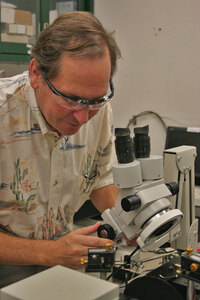DoE grant funds energy research

Research · Mark Thompson, co-director of the federally funded Energy Frontier Research Center, looks at samples with a microscope. | Dieuwertje Kast
Armed with close to $16 million in federal and institutional funding, professor P. Daniel Dapkus is spearheading an initiative to bolster the university’s presence in the burgeoning field of energy research.
Dapkus, who is also co-chair in the USC Ming Hsieh Department of Electrical Engineering, and colleagues affiliated with the departments of electrical engineering, chemistry, physics, astronomy and computer science received a five-year, $12.5 million grant from the U.S. Department of Energy Office of Science in April, and will be holding the first planning meetings within the next few weeks.
The grant is part of the Obama administration’s $777 million Energy Frontier Research Center initiative to accelerate solar cell, biofuel and other energy research.
“Our principal goal is to do basic science research on solar energy conversion and solid state lighting for room lighting and illumination,” said Mark E. Thompson, a professor of chemistry and the center’s co-director. “We also want to develop a better understanding of the devices and study new materials.”
As director of the EFRC for Emerging Materials for Solar Energy Conversion and Solid State Lighting, Dapkus will oversee a suite of projects led by 15 participating faculty, including three from outside universities.
The center, which has full discretion over its funds, will operate independently from USC and the DoE.
In addition, the grant will enable the hiring of 25 new graduate and postdoctoral students.
“Each of the students will gain an appreciation for the challenges and modes of research of the different disciplines and gain a general understanding of the energy landscape,” Thompson said.
The first point Dapkus and Thompson are quick to stress is that they have no intention of building new cells or lights — which may seem counterintuitive given their emphasis on organic solar cells and light-emitting diodes.
Instead, the center plans to focus on developing a better understanding of the underlying components and process — to “take a look at things from the atomic level and engineer them to be the best they can be,” as Dapkus put it.
That could mean exploring the efficiency of new materials, troubleshooting existing ones or developing new structures.
Thompson said the center could eventually bring in business partners to collaborate on new projects and commercialize its work. Even then, Thompson cautions, it would likely take at least 15 to 20 years before the technologies transition from experimental to commercial.
“It’s exciting to work in an area where you’re doing basic science that will lead to something coming out in the marketplace,” Thompson said.
Cost and efficiency — or, more accurately, the lack thereof — are the principal obstacles to the wider deployment of solar cells and LEDs.
According to Dapkus, about a quarter of consumed electricity is used for lighting, of which incandescent bulbs supply a large fraction. Incandescent bulbs are very inefficient because they dissipate most of the electricity they take up as heat.
Compact fluorescent light bulbs, though a preferable alternative because of higher efficiency and longer lifespan, suffer from their own set of shortcomings: cost and their contents — like all fluorescent bulbs, CFLs contain a small amount of mercury, which is toxic to humans.
White LEDs, one of the devices Dapkus’ group is working on, are twice as efficient as CFLs and can emit over the entire light spectrum but are almost 10 times more expensive.
Silicon-based solar cells, which are commonly found in rooftop solar panels have low conversion efficiencies and remain costly compared to conventional fossil fuel-based sources.
Organic solar cells, which are made of low-cost carbon-based materials, offer a promising alternative, but the technology is still in its infancy.
As such, these cells are still too costly and inefficient to make much of an impact beyond the laboratory setting — according to Cody Schlenker, a fifth-year graduate student in Thompson’s lab, they are about a quarter as efficient as silicon-based cells.
“Our goal is to help develop solar cells that will make electricity that is cost-competitive with coal-powered plants,” Dapkus said.
A 10,000-sq. mile area covered by 40 percent efficiency solar cells could theoretically power the entire country, he added.
Schlenker, who will be graduating this year, hopes to take part in the early planning meetings. He is particularly interested in the collaborative efforts the center’s objectives will help foster, both within his department and between the others.
“It gives us a big opportunity to build a new collaborative effort in the chemistry department where we work together with different groups,” Schlenker said.
Separate from the EFRC, Dapkus will also direct the newly established Center for Energy Nanoscience and Technology, which will bring together researchers to devise new projects related to the university’s broader energy initiative.
Though it will primarily draw from researchers in engineering, physics and chemistry, Thompson, who will serve as CENT’s associate director, wants to attract a diverse array of faculty and students.
Ultimately, Dapkus and Thompson hope that the EFRC initiative, combined with the DoE’s other research programs, will rekindle the United States’ dormant energy research sector. Energy research in the U.S. has stagnated in recent decades as other countries, including China, Japan and Germany, have surged ahead.
While Thompson would like to see the federal government inject even more funds into this research, he said he is confident that he and his colleagues will quickly be able to make up for lost ground.
